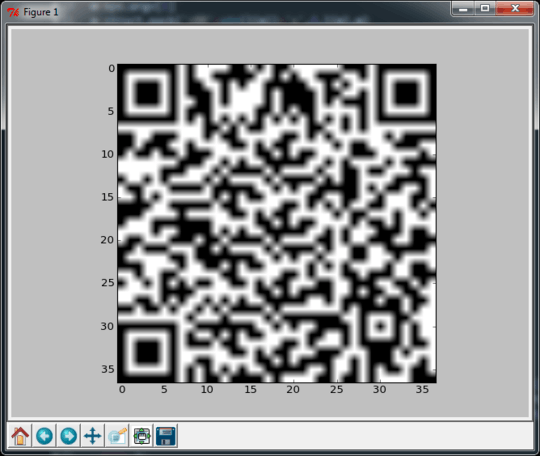Python 3: 974 chars [nb]
Further beat with the ugly stick, see notebook on GH-Gist. Python 3 has built-in ASCII-85 encoding, which helps with the zipped saus. 3's more advanced built-in compression algorithms (LZMA) don't seem to work well with such small things.
Zipping is very fickle about changing characters around, was almost tempted to write something that would randomly try different 1-letter names for variables to minimize the zipped size.
Python 2: 1420 1356 1085 1077 characters

I read the first argument passed when called, which can be a string up to 106-ish characters long. The output is always a version 5-L QR code and mask 4 which means it's 37x37 modules large and can only handle ~5% damage.
The program's only dependencies are numpy (array manipulations) and matplotlib (display only); all Reed-Solomon encoding, data packing, and module layout is handled within the provided code. For RS, I basically robbed the Wikiversity functions...it's still kind of a black-box for me. Learned a ton about QR in any event.
Here's the code before I beat it with the ugly stick:
import sys
import numpy as np
import matplotlib.pyplot as plt
# version 5-L ! = 108 data code words (bytes), 106 after metadata/packing
### RS code stolen from https://en.wikiversity.org/wiki/Reed%E2%80%93Solomon_codes_for_coders#RS_generator_polynomial
gf_exp = [1] + [0] * 511
gf_log = [0] * 256
x = 1
for i in range(1,255):
x <<= 1
if x & 0x100:
x ^= 0x11d
gf_exp[i] = x
gf_log[x] = i
for i in range(255,512):
gf_exp[i] = gf_exp[i-255]
def gf_mul(x,y):
if x==0 or y==0:
return 0
return gf_exp[gf_log[x] + gf_log[y]]
def main():
s = sys.argv[1]
version = 5
mode = 4 # byte mode
dim = 17 + 4 * version
datamatrix = 0.5 * np.ones((dim, dim))
nsym = 26
# PACK
msg = [mode * 16, len(s) * 16] + [ord(c) << 4 for c in s]
for i in range(1, len(msg)):
msg[i-1] += msg[i] // 256
msg[i] = msg[i] % 256
pad = [236, 17]
msg = (msg + pad * 54)[:108]
# MAGIC (encoding)
gen = [1]
for i in range(0, nsym):
q = [1, gf_exp[i]]
r = [0] * (len(gen)+len(q)-1)
for j in range(0, len(q)):
for i in range(0, len(gen)):
r[i+j] ^= gf_mul(gen[i], q[j])
gen = r
msg_enc = [0] * (len(msg) + nsym)
for i in range(0, len(msg)):
msg_enc[i] = msg[i]
for i in range(0, len(msg)):
coef = msg_enc[i]
if coef != 0:
for j in range(0, len(gen)):
msg_enc[i+j] ^= gf_mul(gen[j], coef)
for i in range(0, len(msg)):
msg_enc[i] = msg[i]
# PATTERN
# position marks
for _ in range(3):
datamatrix = np.rot90(datamatrix)
for i in range(4):
datamatrix[max(0, i-1):8-i, max(0, i-1):8-i] = i%2
datamatrix = np.rot90(datamatrix.T)
# alignment
for i in range(3):
datamatrix[28+i:33-i, 28+i:33-i] = (i+1)%2
# timing
for i in range(7, dim-7):
datamatrix[i, 6] = datamatrix[6, i] = (i+1)%2
# the "dark module"
datamatrix[dim-8, 8] = 1
# FORMAT INFO
L4 = '110011000101111' # Low/Mask4
ptr_ul = np.array([8, -1])
steps_ul = [0, 1] * 8 + [-1, 0] * 7
steps_ul[13] = 2 # hop over vertical timing
steps_ul[18] = -2 # then horizontal
ptr_x = np.array([dim, 8])
steps_x = [-1, 0] * 7 + [15-dim, dim-16] + [0, 1] * 7
for bit, step_ul, step_x in zip(L4, np.array(steps_ul).reshape(-1,2), np.array(steps_x).reshape(-1,2)):
ptr_ul += step_ul
ptr_x += step_x
datamatrix[tuple(ptr_ul)] = int(bit)
datamatrix[tuple(ptr_x)] = int(bit)
# FILL
dmask = datamatrix == 0.5
cols = (dim-1)/2
cursor = np.array([dim-1, dim]) # starting off the matrix
up_col = [-1, 1, 0, -1] * dim
down_col = [1, 1, 0, -1] * dim
steps = ([0, -1] + up_col[2:] + [0, -1] + down_col[2:]) * (cols/2)
steps = np.array(steps).reshape(-1, 2)
steps = iter(steps)
# bit-ify everything
msg_enc = ''.join('{:08b}'.format(x) for x in msg_enc) + '0' * 7 # 7 0's are for padding
for bit in msg_enc:
collision = 'maybe'
while collision:
cursor += steps.next()
# skip vertical timing
if cursor[1] == 6:
cursor[1] = 5
collision = not dmask[tuple(cursor)]
datamatrix[tuple(cursor)] = int(bit)
# COOK
mask4 = lambda i, j: (i//2 + j//3)%2 == 0
for i in range(dim):
for j in range(dim):
if dmask[i, j]:
datamatrix[i, j] = int(datamatrix[i, j]) ^ (1 if mask4(i, j) else 0)
# THE PRESTIGE
plt.figure(facecolor='white')
plt.imshow(datamatrix, cmap=plt.cm.gray_r, interpolation='nearest')
plt.axis('off')
plt.show()
if __name__ == '__main__':
main()
After:
import sys
from pylab import*
n=range
l=len
E=[1]+[0]*511
L=[0]*256
x=1
for i in n(1,255):
x<<=1
if x&256:x^=285
E[i]=x;L[x]=i
for i in n(255,512):E[i]=E[i-255]
def f(x,y):
if x*y==0:return 0
return E[L[x]+L[y]]
m=sys.argv[1]
m=[ord(c)*16 for c in'\4'+chr(l(m))+m]
for i in n(1,l(m)):m[i-1]+=m[i]/256;m[i]=m[i]%256
m=(m+[236,17]*54)[:108]
g=[1]
for i in n(26):
q=[1,E[i]]
r=[0]*(l(g)+l(q)-1)
for j in n(l(q)):
for i in n(l(g)):r[i+j]^=f(g[i],q[j])
g=r
e=[0]*134
for i in n(108):
e[i]=m[i]
for i in n(108):
c=e[i]
if c:
for j in n(l(g)):e[i+j]^=f(g[j],c)
for i in n(108):e[i]=m[i]
m=.1*ones((37,)*2)
for _ in n(3):
m=rot90(m)
for i in n(4):m[max(0,i-1):8-i,max(0,i-1):8-i]=i%2
m=rot90(m.T)
for i in n(3):m[28+i:33-i,28+i:33-i]=(i+1)%2
for i in n(7,30):m[i,6]=m[6,i]=(i+1)%2
m[29,8]=1
a=array
t=tuple
g=int
r=lambda x:iter(a(x).reshape(-1,2))
p=a([8,-1])
s=[0,1]*8+[-1,0]*7
s[13]=2
s[18]=-2
P=a([37,8])
S=[-1,0]*7+[-22,21]+[0,1]*7
for b,q,Q in zip(bin(32170)[2:],r(s),r(S)):p+=q;P+=Q;m[t(p)]=g(b);m[t(P)]=g(b)
D=m==0.1
c=a([36,37])
s=r(([0,-1]+([-1,1,0,-1]*37)[2:]+[0,-1]+([1,1,0,-1]*37)[2:])*9)
for b in ''.join('{:08b}'.format(x) for x in e):
k=3
while k:
c+=s.next()
if c[1]==6:c[1]=5
k=not D[t(c)]
m[t(c)]=g(b)
a=n(37)
for i in a:
for j in a:
if D[i,j]:m[i,j]=g(m[i,j])^(j%3==0)
imshow(m,cmap=cm.gray_r);show()
(relying on a tab to count as 4/8/whatever number of spaces >= 2., not sure how well it will copy)
Because it's so long, we can zip it (saw someone do this somewhere else, forgot who though :( ) to save some more characters, bringing the total down to 1085 1077 because pylab is filthy:
import zlib,base64
exec zlib.decompress(base64.b64decode('eJxtU0tzmzAQvvSkX6FLaglkyiM2hHRvyS2HZNobo3QwwY6IBVjQFrfT/96V3KR4Wg5I+/6+3ZXSfWdGOhwHsjWdpv1xX26oclqPtGDKdleTPezrltxCEUm/CKW3iiJyB/YWr9ZkgohsO0MVVS1tWSTi1YrnhE4fP6KFqi2d3qNfPj1CnK0IvS2UhOn6rpgkqHkkxolVFPPceeBviRpJnuot3bJJHG1Sm807AoS5qcevpqUhoX9ut4VN6d8VRymJBuQUlGb3DUGjVHTmiVXci9bUVqyw4uLdwq+eDdszzbmv5TkJp801gkDSgKf8gCSu7cVJF5a6Bqb9Ik7WIkqxLZe8yKMwk2RnW3VGbW3BH1AtLDmJoF3/sPiO+3t24MuIEwetOUVYnY3Bb5bHuvPcFMpv5CNs2Q6TiUPRSAzegSG1yxoll2dkwsxmql+h/8dWgbW69lY5favazKvWs6qNFBX/J8/fChqCyOvaemAsSQX34pPzl5NzYktqMN14FWKbyZzhpW26LicWCmw9z7OlEucibs1FTN7Cg89nQBIbH2e+ypMEQ99uEpjyI46RM+dUJKEbslhb4Gsxc8MsVyKTuMIllMaURzLC+LXf1zhd1Y7EwL7Um6eSTrkaa8NKNvHA1MNz2ddsia+Ac9JDyYpM4ApxMuBoRCS9zC/QilNKyVBEiYTYnlhoGZN7648Ny9D/E7z6YUAci9g9PpshdRQ24iAeLI0fqmcbhczjKA15EedSGDZw/H3CqfU+HK7vfXjA1R1ZzyXs2IY74f6PQG5A44sKIlK5+muRpA6wYQwr2gfALBZEYwUvSV0V/832j4l7V6ehbCzAxSJoOgS4+JmH2ebXIkCLLkfslxv8ZH1quxIvkBD6/Vnta/pyWv3KhyFo62lk3Ml2P/FpAaxzd66c9gXabqQ3SKniuMT6dDlxKwE7k85WpMxn76zMX9Pe4BI00u1CY0NPF/7ImosEm8OJ0sNz951pUemyh0oHO9yJL4ZfOzX/DQ2mdSs='))

If you replace the last line with the following (it adds 62 chars), you get nearly-perfect output, but the other still scans, so whatever.
figure(facecolor='white');imshow(m,cmap=cm.gray_r,interpolation='nearest');axis('off');show()




Mathematica: 20B ;) #~BarcodeImage~"QR"& – hYPotenuser – 2016-03-05T12:07:20.063
@hYPotenuser This is almost the same as a previously deleted answer, deleted because it was a built-in function within the language. – WallyWest – 2016-03-05T12:18:41.940
4Infinite recursion at rule 5. – user12205 – 2014-02-04T00:50:16.557
@ace Well spotted... this has been fixed – WallyWest – 2014-02-04T05:17:54.183
1After reading some documentation, I think "relatively challenging" is an understatement. – Danny – 2014-02-04T17:24:46.143
Can we get a clarification as to what "your code must calculate the QR code image" means? I'm taking it to mean that we must do the two major points in the submitted code: 1) RS encoding, and 2) module layout. – Nick T – 2014-02-04T20:58:03.723
rule 3: so is ascii art printed from a terminal fine, or does it have to go into an actual image file? – None – 2014-05-26T16:52:20.177
also, which of the QR code specifications do we use? how much error correction? – None – 2014-05-26T18:05:36.287
@professorfish ASCII art... hmmm... If you can pull it off then by all means try it... Also the QR specification to be used is whatever works to your advantage... This is code golf, after all... – WallyWest – 2014-05-27T06:47:12.773